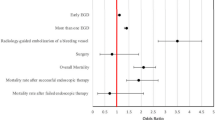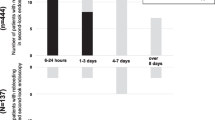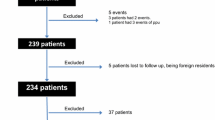Abstract
The short- and long-term bleeding recurrence and mortality of 157 consecutive patients admitted emergently over a period of 2 years with in actively bleeding peptic ulcer were analyzed. They were treated uniformly according to a defined approach where suitable candidates for surgery were operated on early. The data of the 5-year follow-up were analyzed by constructing life tables. There were 94 men and 63 women with a median age of 72.3 years; 83 ulcers were gastric and 74 duodenal. Thirty-one patients underwent an operation. Eleven patients (7%) died within the first month, one in the surgical group. During the follow-up 13 patients rebled and 54 died, two of the deaths related to peptic ulcer disease. The life table for rebleeding and ulcer-related deaths showed a cumulative risk of 11.8% at 5 years, and the cumulative risk was not statistically different between patients according to their age (60 years and older versus younger), sex, the site of their ulcer (gastric versus duodenal), or the type of treatment (conservative versus surgical). With a well defined approach and early selective surgery, the short-term mortality compares favorably with the usual 10% or more reported. The high mortality rate during the follow-up reflects the advanced age of patients with coexisting disease. This long-term follow-up study could be used as a comparison against future studies evaluating new therapies.
Résumé
Les taux de récidives et de mortalité ont été analysés pendant une période d'observation de deux ans chez 157 patients consécutifs opérés en urgence pour un ulcère saignant activement. Ces patients ont été traités de façon homogène selon un protocole dans lequel l'intervention était précoce. La survie a été analysée selon la méthode actuarielle. Il y avait 94 hommes, la médiane d'âge a été de 72.3 ans. Quatre-vingt trois ulcères étaient gastriques, 74 duodénaux. Trente et un patients ont été opérés. Onze des 157 patients (7%) sont décédés pendant le premier mois. Pendant le suivi, 13 patients ont resaigné, 54 sont décédés, deux en rapport avec leur ulcère. Le risque cumulé de récidive hémorragiqueà 5 ans a été de 11.8% et ne différait pas selon l'âge (<60 ans vs>60 ans), le sexe, la localisation de l'ulcère (gastrique vs duodénal) ou le type de traitement (conservateur vs chirurgical). Selon une approche bien définie, et avec une intervention précoce, la mortalité à court terme dans cette série se compare favorablement avec celle de la littérature, qui est de 10% ou plus. La mortalité élevée dans le suivi est un reflet seulement de l'âge avancé des patients ayant des maladies concommitantes. Le suivi rapporté ici peut éventuellement servir de standard auquel peuvent être comparées de nouvelles stratégies thérapeutiques.
Resumen
Se hizo un análisis de la recidiva de sangrado a corto y largo plazo y de la mortalidad de 157 pacientes consecutivos hospitalizados con úlcera péptica sangrante en un período de dos años.
Todos fueron tratados de acuerdo a una conducta definida que incluye operación precoz en pacientes debidamente seleccionados. El análisis del seguimiento a cinco años fue realizado mediante la construcción de tablas de vida. El grupo incluyó 94 hombres; la edad promedio fue 72.3 años. Ochenta y tres de las úlceras fueron gástricas y 74 duodenales. Treinta y un pacientes fueron sometidos a operación. Once pacientes (7%) murieron en el curso del primer mes, uno de ellos en el subgrupo quirúrgico. En el período total de seguimiento se registraron 13 pacientes con sangrado recurrente y 54 murieron, dos debido a enfermedad péptica. La tabla de vida para resangrado y muerte relacionada con úlcera señaló un ríesgo acumulativo de 11.8% a 5 años y el riesgo acumulativo no fue estadísticamente diferente entre los pacientes según su edad (mayores o menores de 60 años), sexo, ubicación de la úlcera (gástrica vs. duodenal) o tipo de tratamiento (conservador vs. quirúrgico).
Con una conducta de manejo bien definida que incluye cirugía precoz en pacientes seleccionados, la mortalidad a corto plazo se compara favorablemente con la tasa usual de 10% o má que informa la literatura. La elevada tasa de mortalidad observada en el seguimiento a largo plazo refleja la edad avanzada de los pacientes con enfermedad coexistente.
El presente estudio de seguimiento a largo plazo puede ser utilizado como punto de comparación para valorar la eficacia de nuevas modalidades terapéuticas en futuros estudios.
Similar content being viewed by others
References
Graham, D.Y.: Should emergency endoscopy be utilized in the management of upper gastrointestinal bleeding of unknown cause? Negative. In Controversies in Gastroenterology, G. Gitnick, editor. New York, Churchill Livingstone, 1984, pp. 153–169
Borland, J.L., Hancock, W.R., Borland, J.L.: Recurrent upper gastrointestinal hemorrhage in peptic ulcer. Gastroenterology 52:631, 1967
Grace, W.J., Mitty, W.F.: Does subtotal gastrectomy in bleeding peptic ulcer prevent recurrence of bleeding? Am. J. Dig. Dis. 7:69, 1962
Johansson, C., Barany, F.: A retrospective study on the outcome of massive bleeding from peptic ulceration. Scand. J. Gastroenterol. 8:113, 1973
Leape, L.L., Welch, C.E.: Late prognosis of patients with upper gastrointestinal hemorrhage. Am. J. Surg. 107:297, 1964
Serebro, H.A., Mendeloff, A.I.: Late results of medical and surgical treatment of bleeding peptic ulcer. Lancet 2:505, 1966
Chinn, A.B., Litell, A.S., Badger, G.F., Beams, A.J.: Acute hemorrhage from peptic ulcer: a follow-up study of 310 patients. N. Engl. J. Med. 255:973, 1956
Müller, C.: Ulkusblutung. In Die proximale selektive Vagotomie in der Behandlung der gastro-duodenalen Ulkuskrankenheiten, C. Müller, S. Martinolli, editors, Berlin, Springer, 1985, pp. 187–211
Panès, J., Viver, J., Forné, M., Garcia-Olivares, E., Marco, C., Garau, J.: Controlled trial of endoscopic sclerosis in bleeding peptic ulcer. Lancet 2:1292, 1987
Chung, S.C.S., Leung, L.W.C., Steele, R.J.C., Crofts, T.J., Li, A.K.C.: Endoscopic injection of adrenaline for actively bleeding ulcers: a randomised trial. B.M.J. 296:1631, 1988
Coldman, A.J., Elwood, J.M.: Examining survival data. Can. Med. Assoc. J. 121:1065, 1979
Silverstein, F.E., Gilbert, D.A., Tedesco, F.J., Buenger, N.K.: The national ASGE survey on upper gastrointestinal bleeding. I. Study design and baseline data. Gastrointest. Endosc. 27:73, 1981
Morgan, A.G., Clamp, S.E.: OMGE international upper gastrointestinal bleeding survey, 1978–1986. Scand. J. Gastroenterol. 23(Suppl. 144):51, 1988
Troidl, H., Vestweber, K.H., Kusche, J., Bouillon, B.: Die Blutung beim peptischen Gastroduodenalulcus: Daten als Entscheidungshilfe für ein chirurgisches Therapiekonzept. Chirurg 57:372, 1986
Jones, A.F.: Haematemesis and melena: with special reference to causation and to the factors influencing the mortality from bleeding peptic ulcers. Gastroenterology 30:166, 1956
Allan, R., Dykes, P.: A study of the factors influencing mortality rates from gastrointestinal haemorrhage. Q. J. Med. 45:533, 1976
Silverstein, F.E., Gilbert, D.A., Tedesco, F.J., Buenger, N.K.: The national ASGE survey on upper gastrointestinal bleeding. II. Clinical prognostic factors. Gastrointest. Endosc. 27:80, 1981
Hunt, P.S.: Surgical management of bleeding chronic peptic ulcer: a 10-year prospective study. Ann. Surg. 199:44, 1984
Jeans, P.L., Padbury, R.T., Toouli, J.: A prospective evaluation of the management of bleeding peptic ulcer. Aust. N.Z. J. Surg. 61:187, 1991
Wheatley, K.E., Dykes, P.W., Keighley, M.R.: Effect of a defined policy on the outcome of bleeding peptic ulcer disease. Gut 29:A1472, 1988
Ceballos, C.J., de Duenas, M.J., Collado, D.E., Martos, G.J.: Descenso de la mortalidad postoperatoria de la ulcera peptica sangrante. Rev. Esp. Enterm. Ap. Dig. 75:671, 1989
Smart, H.L., Langman, M.J.: Late outcome of bleeding gastric ulcer. Gut 27:926, 1986
Boles, R.S., Cassidy, W.J., Jordan, S.M.: Medical versus surgical management for complication of haemorrhage in duodenal ulcer. Gastroenterology 32:52, 1957
Author information
Authors and Affiliations
Rights and permissions
About this article
Cite this article
Mueller, X., Rothenbuehler, JM., Amery, A. et al. Outcome of peptic ulcer hemorrhage treated according to a defined approach. World J. Surg. 18, 406–409 (1994). https://doi.org/10.1007/BF00316821
Issue Date:
DOI: https://doi.org/10.1007/BF00316821




